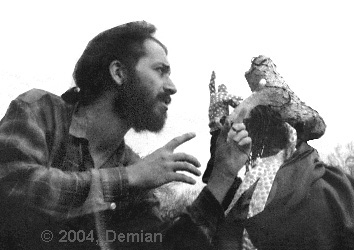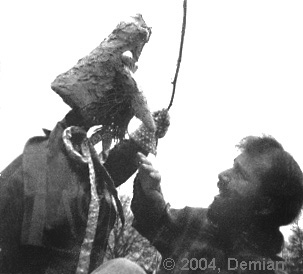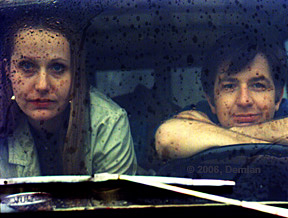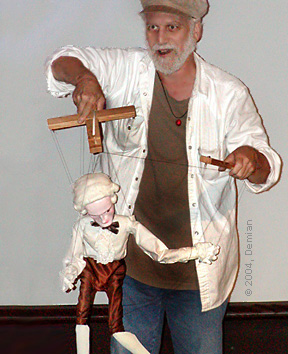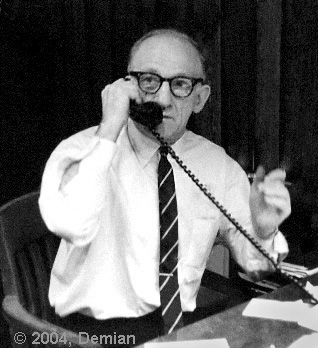
|
presentations that affirm self-esteem and social equality.
.
| MEDIA: Movies: Sweet Corn Vimeo YouTube Photos/Illos: Image Galleries Writings: Articles |
| SERVICES: Digital Production Image Retouch Puppets Script Doctor Shop |
| RESUMES: Directing Writing Visual Acting Web Programming About Sweet Corn About Demian |
| Puppet Projects |
|
Puppets are People by Demian |
Yes they are. And to prove it, here is a shot of me — the director — having a calm, rational discussion with the puppet star of UBU:
Just like real people. |
|
—— Demian’s Puppet Work My use of puppets started — when I was about eight years old — with a Jerry Mahoney plaster head doll that had a movable mouth, as did my Howdy Doody marionette. I also periodically strung up dolls, as well as made my own hand and rod figures. In April 1968, I joined a northeastern states tour with the Nicolo Marionettes out of New York City. The show was “Hiawatha,” based ever so loosely on the Longfellow poem. The figures were Sicilian style, one-third life-size, expertly made by Nick Coppola. Racing from town-to-town, and from state-to-state, three of us ran the show. John Cunningham and Olga Felgemacher were excellent actors and puppeteers. Both did great character voices and were at ease improvising when strings tangled, or during other emergencies — such as the time when John had his hands full working puppets and his pants fell down.
For more touring adventure click here for: The Marionette Tour - 1968 |
|
—— Demian’s Puppet Creations
Here is a photo of “Little One,” from the show The Voice of an Angel: A Castrato Remembers. It was shot at the combined ASIFA-NW (animator’s association, now ASIFA-Seattle) and Puppeteers of Puget Sound meeting, May 21, 2004.
The following list is of puppets that I have made for my own and other productions.
|
|
Demian’s Puppet Heros
My interest in puppets began with 50s TV children’s programming. I was infected by such shows as “Howdy Doody,” which always struck me as being noisy and rude. Other shows had greater use of imagination, such as “Time for Beany” (by Looney Toon animator Bob Clampett), “Kukla, Fran and Ollie,” “Foodini the Great” (and Pinhead), “Johnny Jupiter,” and “Rootie Kazootie” (actually another rude one).
Remembering one of my childhood favorite shows, I got all excited and said we should try and meet him. Bill thought he wouldn’t want to be disturbed, however, I talked him into going with me. Once in Morey Bunin’s office, I asked, “Are you the guy who made Foodini and Pinhead?” He was, indeed. Morey was very happy to find fans who remembered, and cherished his show. He graciously showed us Foodini, who, according to Morey, “does nothing but hang in the closet all day.” We also got a tour of the office and workshop. We not only saw the original hand puppets, we saw the secret workings of a video process that Morey had created, called “Aniforms.” It allowed a TV cartoon line image to respond directly, and personally, to an audience. Morey allowed me to work some of his wonderful puppets, which is heaven for a puppeteer. Morey told us that his company intended to take the Aniforms process as a show to shopping malls and the like. I read later that it was used on various children’s TV shows such as “Captain Kangaroo,” and “The Surprise Show.” In 1932, Morey and his brother Lou had worked for Bil Baird operating marionettes in Macy’s department store windows. The brothers also produced shows using string, rod, hand, and shadow puppets. In the 50s, Morey Bunin collaborated with David Seville to produce the puppets of Alvin and the Chipmunks. According to my correspondence with the daughter of Lou Bunin, Amy Bunin Kaiman, Lou made puppets that appear on the opening credits of the Ziegfeld Follies (MGM 1946). He also did many characters for early television commercials such as ‘Bucky Beaver’ for Ipana toothpaste. Almost all puppet work I saw in my youth was through TV and film. I recall only one, live, professional puppet show, sometime in the 50s in Brookline, Massachusetts, that featured a wonderful interpretation of Dukas’ “The Sorcerer’s Apprentice.” It utilized black light and bubbles (for underwater), which are effects I have since used in many of my own shows. My favorite vents were Shari Lewis (with Lambchop and Charlie Horse), and the incomparable Paul Winchell (with Jerry Mahoney). In the world of marionettes, the top-of-the-line was Bil and Cora Baird. Their work graced various TV specials, and were used in many of the Bell Telephone Science Film Series shown in many public schools. Decades later, the work of Jim Henson, Frank Oz and company, captured my attention. The most sublime puppeteer’s work I ever saw was done by Kukla and Ollie’s creator and operator Burr Tilstrum. In the 60s on “That Was the Week that Was,” a satirical news review, he did a silent portrayal of a news event — the brief lowering of the Berlin Wall — all performed with just his hands. Burr depicted the pain of relatives being ripped apart by the institution of the wall, the ecstasy of re-uniting, and the horror of being forcibly separated once again. By the end of the piece I was sobbing. |
|
Sweet Corn Productions || 206-935-1206 || demian@buddybuddy.com sweetcornmedia.com || Seattle, WA || Founded 1971 All contents © 2023, Demian, Sweet Corn Productions |
